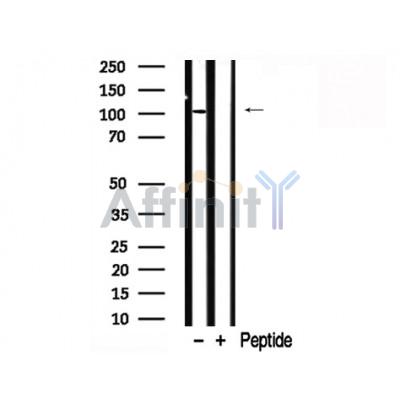alpha 1 Catenin Antibody - #AF7795
| 製品: | alpha 1 Catenin Antibody |
| カタログ: | AF7795 |
| タンパク質の説明: | Rabbit polyclonal antibody to alpha 1 Catenin |
| アプリケーション: | WB |
| 反応性: | Human, Mouse, Rat |
| 予測: | Pig, Zebrafish, Bovine, Horse, Sheep, Rabbit, Dog, Chicken, Xenopus |
| 分子量: | 100kd; 100kD(Calculated). |
| ユニプロット: | P35221 |
| RRID: | AB_2844159 |
製品説明
*The optimal dilutions should be determined by the end user. For optimal experimental results, antibody reuse is not recommended.
*Tips:
WB: For western blot detection of denatured protein samples. IHC: For immunohistochemical detection of paraffin sections (IHC-p) or frozen sections (IHC-f) of tissue samples. IF/ICC: For immunofluorescence detection of cell samples. ELISA(peptide): For ELISA detection of antigenic peptide.
引用形式: Affinity Biosciences Cat# AF7795, RRID:AB_2844159.
折りたたみ/展開
Alpha E-catenin; Cadherin associated protein 102kDa; Cadherin associated protein; Cadherin-associated protein; CAP 102; CAP102; Catenin (cadherin associated protein) alpha 1 102kDa; Catenin (cadherin associated protein), alpha 1, 102kDa; Catenin alpha 1; Catenin alpha-1; CTNA1_HUMAN; CTNNA 1; Ctnna1; FLJ36832; FLJ52416; MDPT2; NY REN 13 antigen; OTTHUMP00000224141; OTTHUMP00000224147; Renal carcinoma antigen NY REN 13; Renal carcinoma antigen NY-REN-13;
免疫原
A synthesized peptide derived from human alpha 1 Catenin, corresponding to a region within N-terminal amino acids.
- P35221 CTNA1_HUMAN:
- Protein BLAST With
- NCBI/
- ExPASy/
- Uniprot
MTAVHAGNINFKWDPKSLEIRTLAVERLLEPLVTQVTTLVNTNSKGPSNKKRGRSKKAHVLAASVEQATENFLEKGDKIAKESQFLKEELVAAVEDVRKQGDLMKAAAGEFADDPCSSVKRGNMVRAARALLSAVTRLLILADMADVYKLLVQLKVVEDGILKLRNAGNEQDLGIQYKALKPEVDKLNIMAAKRQQELKDVGHRDQMAAARGILQKNVPILYTASQACLQHPDVAAYKANRDLIYKQLQQAVTGISNAAQATASDDASQHQGGGGGELAYALNNFDKQIIVDPLSFSEERFRPSLEERLESIISGAALMADSSCTRDDRRERIVAECNAVRQALQDLLSEYMGNAGRKERSDALNSAIDKMTKKTRDLRRQLRKAVMDHVSDSFLETNVPLLVLIEAAKNGNEKEVKEYAQVFREHANKLIEVANLACSISNNEEGVKLVRMSASQLEALCPQVINAALALAAKPQSKLAQENMDLFKEQWEKQVRVLTDAVDDITSIDDFLAVSENHILEDVNKCVIALQEKDVDGLDRTAGAIRGRAARVIHVVTSEMDNYEPGVYTEKVLEATKLLSNTVMPRFTEQVEAAVEALSSDPAQPMDENEFIDASRLVYDGIRDIRKAVLMIRTPEELDDSDFETEDFDVRSRTSVQTEDDQLIAGQSARAIMAQLPQEQKAKIAEQVASFQEEKSKLDAEVSKWDDSGNDIIVLAKQMCMIMMEMTDFTRGKGPLKNTSDVISAAKKIAEAGSRMDKLGRTIADHCPDSACKQDLLAYLQRIALYCHQLNICSKVKAEVQNLGGELVVSGVDSAMSLIQAAKNLMNAVVQTVKASYVASTKYQKSQGMASLNLPAVSWKMKAPEKKPLVKREKQDETQTKIKRASQKKHVNPVQALSEFKAMDSI
種類予測
Score>80(red) has high confidence and is suggested to be used for WB detection. *The prediction model is mainly based on the alignment of immunogen sequences, the results are for reference only, not as the basis of quality assurance.
High(score>80) Medium(80>score>50) Low(score<50) No confidence
研究背景
Associates with the cytoplasmic domain of a variety of cadherins. The association of catenins to cadherins produces a complex which is linked to the actin filament network, and which seems to be of primary importance for cadherins cell-adhesion properties. Can associate with both E- and N-cadherins. Originally believed to be a stable component of E-cadherin/catenin adhesion complexes and to mediate the linkage of cadherins to the actin cytoskeleton at adherens junctions. In contrast, cortical actin was found to be much more dynamic than E-cadherin/catenin complexes and CTNNA1 was shown not to bind to F-actin when assembled in the complex suggesting a different linkage between actin and adherens junctions components. The homodimeric form may regulate actin filament assembly and inhibit actin branching by competing with the Arp2/3 complex for binding to actin filaments. May play a crucial role in cell differentiation.
Sumoylated.
Phosphorylation seems to contribute to the strength of cell-cell adhesion rather than to the basic capacity for cell-cell adhesion.
Cytoplasm>Cytoskeleton. Cell junction>Adherens junction. Cell membrane>Peripheral membrane protein>Cytoplasmic side. Cell junction.
Note: Found at cell-cell boundaries and probably at cell-matrix boundaries.
Cell membrane>Peripheral membrane protein>Cytoplasmic side.
Expressed ubiquitously in normal tissues.
Belongs to the vinculin/alpha-catenin family.
研究領域
· Cellular Processes > Cellular community - eukaryotes > Adherens junction. (View pathway)
· Environmental Information Processing > Signal transduction > Hippo signaling pathway. (View pathway)
· Human Diseases > Infectious diseases: Bacterial > Bacterial invasion of epithelial cells.
· Human Diseases > Cancers: Overview > Pathways in cancer. (View pathway)
· Human Diseases > Cancers: Specific types > Endometrial cancer. (View pathway)
· Human Diseases > Cancers: Specific types > Gastric cancer. (View pathway)
· Human Diseases > Cardiovascular diseases > Arrhythmogenic right ventricular cardiomyopathy (ARVC).
· Organismal Systems > Immune system > Leukocyte transendothelial migration. (View pathway)
Restrictive clause
Affinity Biosciences tests all products strictly. Citations are provided as a resource for additional applications that have not been validated by Affinity Biosciences. Please choose the appropriate format for each application and consult Materials and Methods sections for additional details about the use of any product in these publications.
For Research Use Only.
Not for use in diagnostic or therapeutic procedures. Not for resale. Not for distribution without written consent. Affinity Biosciences will not be held responsible for patent infringement or other violations that may occur with the use of our products. Affinity Biosciences, Affinity Biosciences Logo and all other trademarks are the property of Affinity Biosciences LTD.
